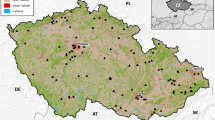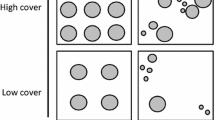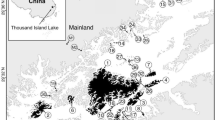Abstract
Land use changes operate at different scales. They trigger a cascade of effects that simultaneously modify the composition or structure of the landscape and of the local vegetation. Mobil animals, and birds in particular, can respond quickly to such multi-scalar changes. We took advantage of a long term study on the response of songbirds to land-use changes on four Mediterranean islands in Corsica and Sardinia to explore the benefits of a multi-scale analysis of the relationships between songbird distribution, vegetation structure and landscape dynamics. Field data and aerial photographs were used to describe the vegetation at three different scales. Birds were censused by point counts. We used statistical variance decomposition to study how bird distribution and vegetation at various scales were linked. We analysed multi-scale vegetation changes (floristic composition, plot vegetation type, and landscape structure) and their consequences on bird distribution with multivariate and non-parametrical tests. The distribution of most species was linked to at least two spatial scales. The weight of a given scale was consistent with life-history traits for species whose biology was well-known. In the examples studied, vegetation composition, vegetation type and landscape changes that resulted from land abandonment negatively affected birds depending on open or heterogeneous areas. Our results emphasize that multi-scale analyses can greatly enhance our understanding of bird distribution and of their changes. Management of these populations should take into account measures at various spatial scales depending on the sensitivity of the species.





Similar content being viewed by others
References
Augustin NH, Mugglestone MA, Buckland ST (1996) An autologistic model for the spatial distribution of wildlife. J Appl Ecol 33:339–347
Bersier L-F, Meyer DR (1994) Bird assemblages in mosaic forests: the relative importance of vegetation structure and floristic composition along the successional gradient. Acta Oecol 15:561–576
Bibby CJ, Burgess ND, Hill DA (1992) Bird census techniques. Academic Press, London
Blondel J, Aronson J (1999) Biology and the wildlife of the Mediterranean region. Oxford University Press, Oxford
Blondel J, Ferry C, Frochot B (1981) Points count with unlimited distance. Stud Avian Biol 6:414–420
Brotons L, Wolff A, Paulus G, Martin J-L (2005) Effect of adjacent agricultural habitat on the distribution of passerines in natural grasslands. Biol Conserv 124:407–414
Burel F, Baudry J (1999) Ecologie du paysage. Concepts, méthodes et applications. TEC&DOC, Paris
Cramp S (1977) Handbook of the birds of Europe, the Middle East and North Africa. The birds of the Western Palearctic. Oxford University Press, Oxford
Cushman SA, McGarigal K (2002) Hierarchical, multi-scale decomposition of species-environment relationships. Landscape Ecol 17:637–646
Debussche M, Escarré J, Lepart J, Houssard C, Lavorel S (1996) Changes in Mediterranean plant succession: old-fields revisited. J Veget Sci 7:519–526
Entraygue M (2004) Les oiseaux reproducteurs de la plaine viticole de Patrimonio, Corse. Mémoire de maîtrise. Université de Corse, Corte, 32pp
Fleishman E, McDonal N, McNally R, Murphy DD, Walters J, Floyd T (2003) Effects of floristics, physiognomy and non-native vegetation on riparian bird communities in a Mojave Desert watershed. J Anim Ecol 72:484–490
Forman RT, Gordron M (1986) Landscape ecology. John Wiley, New York
Grand J, Cushman SA (2003) A multi-scale analysis of species-environment relationships: breeding birds in a pitch pine-scrub oak (Pinus rigida-Quercus ilicifolia) community. Biol Conserv 112:307–317
Griffith DA, Peres-Neto PR (2006) Spatial modelling in ecology: the flexibility of eigenfunction spatial analyses. Ecology 87:2603–2613
Herrando S, Brotons L (2002) Forest bird diversity in Mediterranean areas affected by wildfires: a multi-scale approach. Ecography 25:161–172
Howell CA, Latta SC, Donovan TM, Porneluzi PA, Parks GR, Faaborg J (2000) Landscape effects mediate breeding bird abundance in Midwestern forests. Landscape Ecol 15:547–562
Jokimäki J, Huhta E (1996) Effects of landscape matrix and habitat structure on a bird community in northern Finland: a multi-scale approach. Ornis Fenn 73:97–113
Legendre P, Legendre L (1998) Numerical ecology, 2nd English edn. Elsevier Science B.V., Amsterdam
Legendre P, Dale MRT, Fortin M-J, Gurevitch J, Hohn M, Myers D (2002) The consequences of spatial structure for the design and analysis of ecological field surveys. Ecography 25:601–615
Lepart J, Debussche M (1992) Human impact on landscape patterning: Mediterranean examples. In: Hansen A J, di Castri F (eds) Landscape boundaries, consequences for biotic diversity and ecological flows. Springer, New York, pp 76–106
Levin SA (1992) The problem of pattern and scale in ecology. Ecology 73:1943–1967
Lichstein JW, Simons TR, Shriner SA, Franzreb KE (2002) Spatial autocorrelation and autoregressive models in ecology. Ecol Monogr 72:445–463
MacFaden SW, Capen DE (2002) Avian habitat relationships at multiple scales in a New England forest. For Sci 48:243–253
MacKenzie DI, Nichols JD, Lachman GB, Droege S, Royle JA, Langtimm CA (2002) Estimating site occupancy rates when detection probabilities are less than one. Ecology 83:2248–2255
Marceau DJ (1999) The scale issue in the social and natural science. Can J Remote Sens 25:347–356
Martin J-L (1992) Niche expansion in an insular land bird community: a different perspective. J Biogeogr 19:375–381
Martin J-L, Thibault J-C (1996) Coexistence in Mediterranean warblers: ecological differences or interspecific territoriality. J Biogeogr 23:169–178
McCullagh P, Nelder JA (1989) Generalised linear models. Chapman & Hall, London
Moran PAP (1950) Notes on continuous stochastic phenomena. Biometrika 37:17–23
Moreira F, Beja P, Morgado R, Reino L, Gordinho L, Delgado A, Borralho R (2005) Effects of field management and landscape context on grassland wintering birds in Southern Portugal. Agric Ecosyst Environ 109:59–74
Poyatos R, Latron J, Llorens P (2003) Land-use and land-cover change after agricultural abandonment. Mountain Res Dev 23:52–58
Preiss E, Martin J-L, Debussche M (1997) Rural depopulation and recent landscape changes in a Mediterranean region: consequences to the breeding avifauna. Landscape Ecol 12:51–61
Prodon R, Lebreton J-D (1994) Analyses multivariées des relations espèces-milieu: structure et interprétation écologique. Vie et Milieu 44:69–91
Racheli G (1982) L’archipelago de la Maddalena, nella storia. Vert Sardegna
Romero-Calcerrada R, Perry GLW (2004) The role of land abandonment in landscape dynamics in the SPA ‘Encinares del rio Alberche y Cofio’, Central Spain, 1984–1999. Landscape Urban Plan 66:217–232
Sawada M (1999) An Excel 97/2000 visual basic (VB) add-in for exploring global and local spatial autocorrelation. Bull Ecol Soc Am 80:231–234
Selmi S, Bouliner T, Faivre B (2003) Distribution and abundance patterns of a newly colonizing species in Tunisian oases: the Common Blackbird Turdus merula. Ibis 145:681–688
Sirami C (2003) Structure de la végétation et distribution spatio-temporelle de l’avifaune des paysages méditerranéens: le cas du Pic Saint Loup. Mémoire DEA « biologie de l’évolution et écologie ». Université Montpellier 2, Montpellier, France, 33pp
Skowno AL, Bond WJ (2003) Bird community composition in an actively managed savannah reserve, importance of vegetation structure and vegetation composition. Biodivers Conserv 12:2279–2294
Stephens SE, Koons DN, Rotella JJ, Willey DW (2003) Effects of habitat fragmentation on avian nesting success: a review of the evidence at multiple spatial scales. Biol Conserv 115:101–110
Suarez-Seoane S, Osborne PE, Baudry J (2002) Responses of birds of different biogeographic origins and habitat requirements to agricultural land abandonment in northern Spain. Biol Conserv 105:333–344
Ter Braak CJ (1987) The analysis of vegetation-environment relationships by canonical correspondent analysis. Vegetatio 69:69–77
Thibault J-C, Martin J-L, Guyot I (1990) Les oiseaux terrestres nicheurs des Iles Mineures des Bouches-de-Bonifacio: Analyse du peuplement. Alauda 58:173–185
Tworek S (2002) Different bird strategies and their responses to habitat changes in an agricultural landscape. Ecol Res 17:339–359
Vitousek PM (2002) Oceanic islands as model systems for ecological studies. J Biogeogr 29:573–582
Wiens JA (1989) Spatial scaling in ecology. Funct Ecol 3:385–397
Wiens JA, Stenseth NC, Van Horne B, Ims RA (1993) Ecological mechanisms and landscape ecology. Oikos 66:369–380
Wu J, Loucks OL (1995) From balance of nature to hierarchical patch dynamics: a paradigm shift in ecology. Quart Rev Biol 70:439–466
Acknowledgements
We thank Isabelle Guyot and Jean-Claude Thibault for their help in collecting data and Jean-Pierre Ribeyre for his navigation skills. Thank you to Hervé Bobhot for his help with GIS softwares and spatial processing of aerial photographs. Lluis Brotons and Clelia Sirami provided valuable suggestions and comments to an earlier draft. This research was funded by the GRDE "Mediterranean and Mountain Ecosystems in a Changing World" a partnership between France and Spain.
Author information
Authors and Affiliations
Corresponding author
Rights and permissions
About this article
Cite this article
Coreau, A., Martin, JL. Multi-scale study of bird species distribution and of their response to vegetation change: a Mediterranean example. Landscape Ecol 22, 747–764 (2007). https://doi.org/10.1007/s10980-006-9074-2
Received:
Accepted:
Published:
Issue Date:
DOI: https://doi.org/10.1007/s10980-006-9074-2





